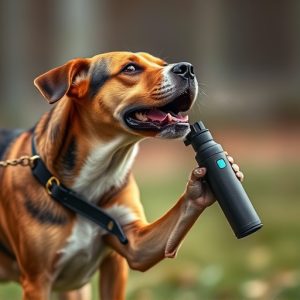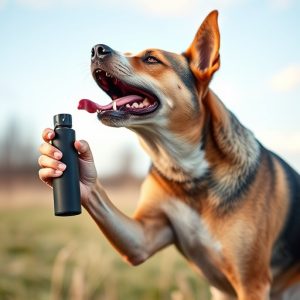Safe Pepper Spray Dog Defense: Legal Guidelines and Alternative Methods
Safe pepper spray dog defense methods using capsaicin offer a non-lethal alternative for dealing wit…….
Safe pepper spray dog defense methods using capsaicin offer a non-lethal alternative for dealing with aggressive dogs. Legal in many places as a last resort, these methods require understanding local regulations and proper usage techniques. By prioritizing safety and responsible use, individuals can effectively protect themselves and their pets while promoting better coexistence with urban dogs, all while adhering to legal guidelines.
Animal control spray, commonly known as pepper spray, has gained attention as a controversial tool for dog defense. This article delves into the legal intricacies surrounding its use, offering a comprehensive guide on safe application techniques. We explore when it’s legally acceptable to deploy such methods and present alternative non-lethal deterrents. Through real-world case studies, we examine the impact and reconsiderations these practices bring, emphasizing responsible and effective dog management strategies, including safe pepper spray defense methods.
- Understanding Animal Control Spray: What It Is and Its Legal Status
- Safe Use Guidelines for Pepper Spray in Dog Defense
- When is it Legally Acceptable to Use Animal Control Spray?
- Alternative Non-Lethal Methods for Dog Deterrence
- Case Studies: Real-World Applications and Legal Reconsiderations
Understanding Animal Control Spray: What It Is and Its Legal Status
Animal control spray, also known as pepper spray or oleoresin capsicum (OC) spray, is a non-lethal self-defense tool designed to temporarily incapacitate an aggressor, providing individuals with a safe method to protect themselves against dogs and other animals. This spray contains capsaicin, the same compound that gives chili peppers their heat, and when sprayed into the eyes and face, it causes temporary blindness, tearing, and intense pain, giving the user precious time to escape or de-escalate the situation.
The legal status of animal control spray varies across jurisdictions. In many countries and states, it is classified as a legal defense method for individuals facing dog attacks or other animal assaults. However, regulations regarding its possession, carrying, and use are stringent. Some areas require a permit or license to carry pepper spray, while others have restrictions on the concentration and amount allowed. It’s crucial to understand local laws and consult with relevant authorities to ensure safe and legal use of this defense method, especially when considering it as a safe pepper spray dog defense method.
Safe Use Guidelines for Pepper Spray in Dog Defense
When considering safe pepper spray dog defense methods, it’s crucial to understand that using any type of spray on animals should be a last resort and only when all other options have been exhausted. Pepper spray can cause significant distress and potential health issues for dogs, so it’s important to follow strict guidelines for its use. These include ensuring the product is specifically designed for animal defense, checking local laws regarding its possession and use, and familiarizing yourself with safe application techniques.
Safe use involves keeping the spray out of reach of children and pets, storing it in a secure location, and understanding the recommended range and timing for deployment. It’s also vital to be aware of any potential allergies or sensitivities your dog may have that could interact negatively with pepper spray. Regular training sessions can help acclimatize your pet to the scent and reduce its distress response, making safe pepper spray dog defense methods more effective and less stressful for both you and your animal companion.
When is it Legally Acceptable to Use Animal Control Spray?
In many jurisdictions, the use of animal control spray, often referred to as safe pepper spray for dog defense, is governed by strict regulations to ensure public safety and responsible usage. It is typically legal to employ such sprays in self-defense against aggressive animals, particularly dogs, when other less-lethal methods have been exhausted or are ineffective. For instance, if a dog charges towards you with the intent to cause harm, and all other attempts to deter it have failed, using animal control spray might be considered a proportionate response.
The legality of safe pepper spray for dog defense also hinges on factors such as the specific regulations in your area, the type of spray used (its concentration and active ingredients), and whether you are a member of the public or a professional, like a wildlife officer or security guard. It’s crucial to understand and adhere to local laws to avoid potential consequences and ensure that the use of animal control spray remains a last resort for personal safety.
Alternative Non-Lethal Methods for Dog Deterrence
In recent years, there’s been a growing interest in safe and effective non-lethal methods for dog deterrence, particularly focusing on safe pepper spray dog defense methods. These alternatives to traditional lethal controls offer a humane way to protect both humans and animals. Unlike traditional chemical sprays that can cause harm or even death, safe pepper spray is designed to temporarily incapacitate a dog without causing lasting damage.
The use of safe pepper spray dog defense methods is particularly useful in urban areas where dogs may roam freely and pose a risk to residents and other pets. These non-lethal solutions allow for a more responsible approach to animal control, promoting coexistence between humans and their canine neighbors while ensuring everyone’s safety.
Case Studies: Real-World Applications and Legal Reconsiderations
In recent years, there has been a growing interest in safe pepper spray dog defense methods as an alternative to traditional animal control techniques. Case studies from various regions have shown promising results with minimal negative impact on both pets and their owners. For instance, in urban areas plagued by aggressive dog encounters, local communities have implemented pilot programs using specialized non-lethal sprays. These solutions often contain capsaicin, the active ingredient in chili peppers, delivered through a handheld device designed for animal deterrence. The studies indicate that such methods can effectively discourage unwanted behavior without causing severe harm.
Moreover, legal reconsiderations have followed these real-world applications. Many countries and states are now reevaluating their animal control regulations to include safe pepper spray dog defense as a legitimate option. This shift is driven by concerns over the welfare of both animals and humans, as well as the limitations of more forceful methods. As a result, pet owners have access to a wider range of tools for protecting themselves and their pets, promoting better coexistence with urban wildlife. Safe pepper spray methods represent a modern approach that balances public safety with animal welfare, promising a brighter future for peaceful interactions between humans and their four-legged neighbors.
In conclusion, while animal control spray, particularly pepper spray for dog defense, offers a non-lethal option for managing aggressive canine behavior, its legal use is subject to stringent regulations. Understanding the safe use guidelines and local laws regarding its application is paramount. The article has explored these aspects, highlighting the importance of considering alternative, humane methods like positive reinforcement training alongside traditional deterrents. By adhering to responsible practices and exploring diverse strategies, individuals can effectively manage dog interactions while navigating legal boundaries, ensuring both animal welfare and public safety.


